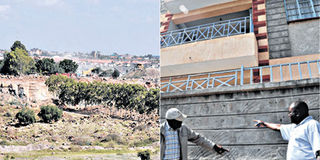Premium
Quarry making life hell for posh Kitengela estates

Kaputiei residents want the quarry moved. Photos | GERALD ANDERSON
At a glance, Kaputiei in Kitengela, Kajiado County, looks like an ideal place to build a home.
The area boasts modern bungalows and maisonettes that exude affluence, with neatly trimmed hedges or perimeter walls with imposing metal gates.
And remarkably, despite the scorching Kitengela sun, most of the houses look as if they received a fresh coat of paint only recently.
The area has, indeed, undergone a radical transformation and is a far cry from the bare, dusty piece of land it once was.
However, behind this impressive façade are residents who are always worrying about their health and the condition of their houses, thanks to a quarry that is smack in the middle of this residential area.
Surrounded by a high wall, it has made life miserable for the residents of Chuna, Kitengela Yukos, and Milimani estates, who complain about the noise and pollution it causes.
Things are particularly bad on Tuesday, Wednesday, and Thursday afternoons when the residents have to put up with loud blasts and dust when the quarry is most active.
It is taking a toll, not just on their health, but on their houses as well, they say.
Blasts and dust
Martha Wanjiku, who runs a business less than 100 metres from the quarry, knows this routine only too well.
“Usually, there is the wail of a siren and after a short while there is a huge blast that shakes the ground, making you feel as if you are about be hurled into the air. It makes chairs and stuff on the floor or on the shelves move. I once almost toppled over in my chair.
“After the blast there is so much dust that we are forced to close our shops and wait for it to settle. Some customers have fled on hearing the blasts. Some have never come back.”
Meanwhile, Hellen Luvisia, who lives about 500 metres away, says that while she gets affected by just “a little dust”, the blasts are taking a toll on her house.
“Every so often we have to fill a crack. I have painted and repainted my house, but the cracks continue appearing. In fact, I am afraid that the foundation of my house — and of those around here — have been shaken and these houses could easily crumble,” she says.
She recalls, two years ago, when a stone from the quarry went flying through the air and killed two goats on the road. “Imagine what damage it would have done if it had landed on a car or people,” she says.
Residents say the impact of the blasts can also be seen on the roofs, where the tiles have been dislodged. As a result, they say, their ceilings have patches and damp sections and despite repairs, they still leak when it rains.
“Our roof tiles are placed with an inch overlap. The frequent blasts have seen the tiles move, making the roofs leak,” says Ms Luvisia.
The residents say the blasts are so powerful that most houses in the area have cracks on the walls, with the tiles on some floors jutting out.
In an attempt to mitigate the impact, some of the home owners have built an extra wall around their houses.
Jackson Amboga, a retired telecommunication engineer, says he has not known peace since he moved to the area, adding that the worst incident occurred when his daughter came visiting.
“She was feeding her baby when the blast occurred. As she fled in panic, the baby fell from her lap. She did not know what was happening. She panicked, we all panicked,” he recalls.
The National Environment Management Authority’s (Nema) Legal Notice No. 61 on the Environmental Management and Coordination (Noise and Excessive Vibration Pollution) (Control) Regulations of 2009 has guidelines on noise and excessive vibrations from quarries.
Article 14, Section (2) states that “The relevant lead agency shall ensure that mines and quarries where explosives and machinery are used are located in designated areas and not less than two kilometres away from human settlements.”
However, the Kaputiei quarry is in the middle of a residential area, with some houses barely 100 metres away from its perimeter wall.
The residents have expressed fears about the quarry’s effects on their lives but no concrete action has been taken.
In a letter dated 11 September, 2002, to the quarry’s directors, Karsan Ramji & Sons, reference number X/4//40/(22), the then Ministry of Environment and Natural Resources wrote: “With the continued expansion of human settlement, the quarry will eventually have to be relocated to another isolated area.”
What was even more worrying for the residents was that the quarry’s owners had shown an interest in setting up a mini cement plant on Plot L.R. No. Kajiado/Kaputiei North/3031, which borders the residential area.
Led by Prof Vincent Simiyu, the residents have opposed the move. Said Simiyu: “Literature and several studies have shown that cement plants release toxins into the environment.
“Considering the proximity of the would-be factory to our homes, we are at risk of a myriad infections, and not just the older people, but our grandchildren as well.”
Environmental impact study
Meanwhile, an environmental impact assessment of the area recommended that the cement plant be set up elsewhere since “the mini cement grinding plant would be opposed by the neighbours on the basis of cumulative increment of environmental risks associated with the quarry facility.”
The report recommended that the proposed cement factory be set up in Athi River, approximately 8 km from Kaputiei.
The location is designated an industrial area and there are at least four other major cement manufacturing plants in its immediate neighbourhood, namely Mombasa Cement, Bamburi Cement, Athi River Mining, and East Africa Portland Cement.
Contacted for comment, Mr Kishon Varsani, the managing director of Karsan Ramji & Sons, said: “The residents should not worry about a cement factory. We have moved to a new location.”
However, while that may be good news, the local residents continue to suffer. Margret Anya, who has children, says: “We have been suffering from one respiratory problem after another. My children associate the blasts and sirens with panic and illness. The quarry should be relocated or the land converted to a residential area.”
DN2 could not get a comment from the quarry owners regarding the noise and pollution.
Meanwhile, as the residents of Chuna, Kitengela Yukos, and Milimani estates wait for help, they are bracing themselves for more blasts and dust this afternoon.





